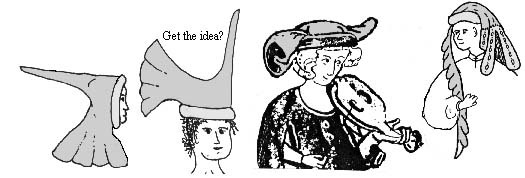
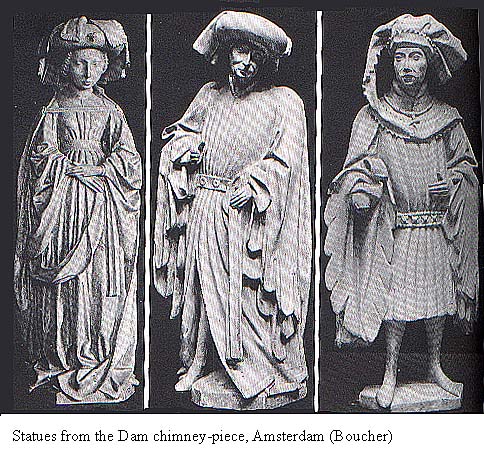
The stuffed hat is an easy and entertaining accessory to the clothing
of the high middle ages. It requires very little labor, and produces a
marvelous effect for such small effort.
I like to have my hats match my
garb, but I have seen only one medieval hat that matched the outfit it
was worn with, so go wild with lengths of fabric that you can't bear to
throw away. You can trim these hats with dags, bells, "nailheads", beads,
etc., and you can "parti" them, too.
The stuffed torus (donut) hat seems to have evolved from the basic
men's hood, although I have heard theories that it was a novel idea brought
back by crusaders who had seen turbans in their travel. Although there
are some circular women's hats that look very turban-like,
I give greater credence to the hood derivation. Men's hats stay much
closer to their hoodlike origins in appearance.
In the medieval pictures, these hats are worn with either the basic voluminous houppelande, the shorter houppelande (sometimes called the haincelin) or other garments with too much fabric. Sometimes the stuffed roll hat was worn over the shoulder, ornamentally, while the man wore a tall stiff hat on his head.
Let's run through hoods very briefly (if you're very interested in hoods, see my other class notes on hoods.) If you take a basic hood (figure 1), take it off your head, roll up the face opening, and put it back on your head with the face opening around the top of your head (figure 2), you get a hat. There are several extant pictures of men doing this with their hoods from as early as 1316 (fig. 3). Eventually the "liripipe" (the tail at the back of the head) became longer and decorated, as did the skirt fabric which lies over the shoulders. (fig 4. from a tapestry in the mid-15th century.)

Sometime in the middle of this process, men are seen wearing stuffed-roll hats -- things that look like hoods, but are so full and stuffed on the donut-shape around the face, that they must be separate items. In Boucher's 20,000 years of fashion, there is a sketch of a support item for this donut shape.
For men, the stuffed hat always had at least the cocks' comb (former 'skirts' of the hood), and often had a liripipe. Sometimes the liripipe could be used to tie the cockscomb into interesting groupings.
Most of my information is oriented towards Northern Europe, but men wore roll hats in Italy as well. The Italian versions were often much larger than the northern variants; up to a foot thick, to judge by the pictures. Their northern cousins wore roll hats that were about the thickness of a forearm at most. The rolls should not get too thin -- they are not at all like the thin headbands currently fashionable for women! They should be at least 3" in diameter.
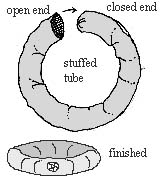 Suggested
fabrics: anything. Well, anything you'd wear to an SCA event. In general,
use woven natural fabrics, such as cotton, linen or wool. If you're
not sure what sort of hat you want, or don't trust your design skills,
copy one of the ones in this handout, or from a medieval illustration.
Suggested
fabrics: anything. Well, anything you'd wear to an SCA event. In general,
use woven natural fabrics, such as cotton, linen or wool. If you're
not sure what sort of hat you want, or don't trust your design skills,
copy one of the ones in this handout, or from a medieval illustration.
1. Cut a piece of fabric 1 yard long by whatever diameter roll you want. Cut this on the straight grain (square to the weaving), not on the bias. Most of my hats start 7" wide for a 6" final circumference. Sew it into a tube with one closed end; turn inside out. Some folks swear by cutting on the bias and stiff stuffing to eliminate interior wrikles. I don't think it's necessary; there aren't a lot of wrinkles with this on the grain method.
2. Stuff with stuffing. It's often very
useful to have some sort of "piston" to help you get the stuffing packed
in uniformly. Try a tall thin drinking glass or other cylindrical object.
The idea with the stuffing is to get it firmly enough to keep the shape,
but not so dense that it can't compress very well. You'll have to experiment.
A 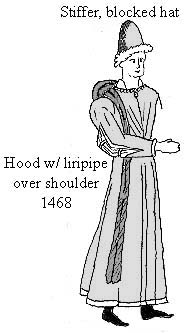 period
source mentions the "hair of dead women," but since that's in fairly short
supply these days, I like to use the standard polyester stuffing that you
can buy in any fabric store. I have no evidence for the following, but
they might work well also: wood shavings (thin curls--not sawdust), moss,
spanish moss, fabric scraps, unspun wool. A friend recalls seeing a round
cork shape in a museum which was made to be rolled up inside a hood to
give the stuffed effect, but I do not have any source material on this
option.
period
source mentions the "hair of dead women," but since that's in fairly short
supply these days, I like to use the standard polyester stuffing that you
can buy in any fabric store. I have no evidence for the following, but
they might work well also: wood shavings (thin curls--not sawdust), moss,
spanish moss, fabric scraps, unspun wool. A friend recalls seeing a round
cork shape in a museum which was made to be rolled up inside a hood to
give the stuffed effect, but I do not have any source material on this
option.
Other options I have seen used an expandable aluminum dryer tube, fasioned
in a circle; it was lightweight and flexible -- both key points!
I've also seen one of those bound-straw wreath forms used; I wouldn't advise
these, as they are both heavy and not flexible. Although these hats
look round, they need to assume an oval shape when you are wearing them,
due to the way human heads are made.
3. As you stuff, occasionally bend the tube around your head to see how you are progressing. When you get to the point where the closed end of the tube and the empty end of the tube (where the stuffing ends) meet, it is time to figure out exactly how tight you want the roll to fit. If you're going to put a wire in the roll, to shape it into a V in front, now is the time for that.
4. When you've got the perfect roll, tuck the non-filled part of the tube back inside its own end, leaving a 2" `collar' of open fabric at the end. Slide this over the closed end and baste together. Now you have a fine donut.
5. Add cockscomb and liripipe -- see illustrations below. Note that the different colors are for illustration purposes only. The hat should all be the same color, OR parti'd down the center line in two colors. I believe that the one-piece liripipe & cockscomb is the most medieval if you want both 'accessories.'
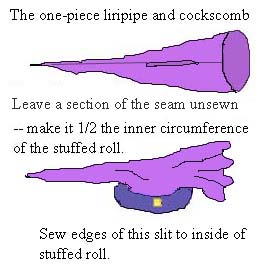
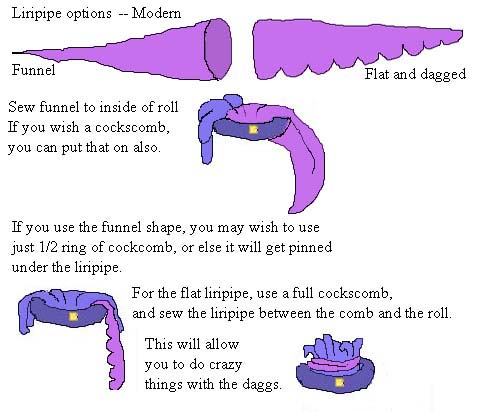
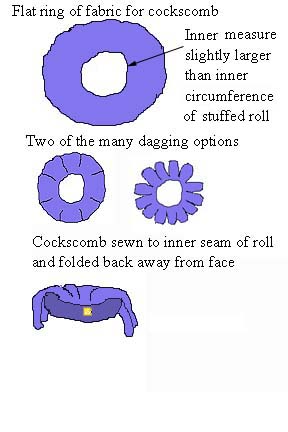
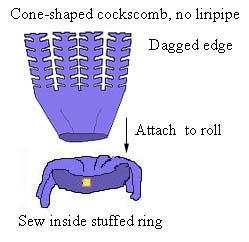
Look through the other clothing handouts for more pictures.
If you have questions, feel free to email me.
| All material (c) 2000 Cynthia Virtue | Email Author with comments |
| Back to Virtue Ventures Main Page | Back to Article Index |